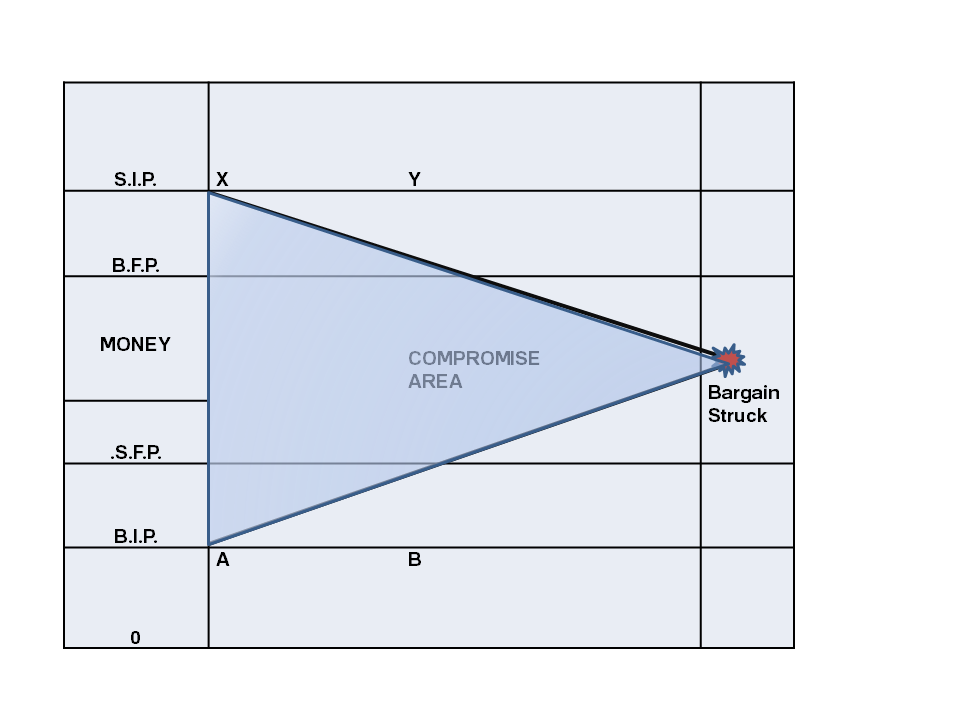Introduction
This model is a tool for summarizing the planning process before negotiations commencing and plotting progress towards agreement during the negotiation. Basic assumptions are that:
- Every negotiating issue is quantifiable in terms of money even where a purely subjective judgement is used as to an issues worth.
- All negotiations take place over time and that there are deadlines for both parties to reach agreement.
- Both negotiating parties are looking for compromise to a lesser or greater degree, i.e. a process of coming to agreement over allocating scarce resources.
- Both parties are maximizing e.g. buyers want the lowest price and sellers want to sell at the highest price possible.
At this point we can build a model using the example of a buyer and seller.
Hicks Model
WHERE
B.F.P. – Buyers Fallback Price; B.I.P – Buyers Ideal Price
S.F.P. – Sellers Fallback Price; S.I.P. – Sellers Ideal Price
T.S. – Sellers Deadline; T.B. – Buyers Deadline
 TIME TS TB
TIME TS TB
By establishing in the planning phase, and confirming through early negotiation phases, the users can construct the Compromise Area, which might favor either party. Where there is no overlap between the two parties, e.g. S.F.P. is greater than B.F.P., it is likely that either or both are being unrealistic, and there is no basis for a bargain.
The next stage is to consider the deadline by which agreement is needed. The tighter the deadline for either party dictates the overall speed at which agreement is reached.
In reality, these two converging lines shown above will not be straight; in fact it could be almost any shape. Whatever the shape the curves will summarize the stand (s) taken throughout the negotiation period (s) e.g. if a buyer is giving nothing away in the first period of negotiation, his line will be parallel to the time axis (see Fig.1, Lines A and B), and could gain an equal and opposite response of line x – y from the seller.
Behind such lines, will be a complex set of behaviors, but at any point the user has a shorthand description for how the negotiation is progressing, and give
useful information about what response; move (s) could have on the other party.
For the model to be useful you have to decide, before starting what your own give and take limits, (ideal and fallback) and then try to predict their opponents give and take limits depending on relative strengths and weaknesses, arguments, etc. This will then set up the degree to which it is felt there is an overlap or compromises are and a basis of negotiation.
Where there is no overlap between the two parties e.g. sellers fallback price is greater than the buyer’s fallback price it is likely that either or both are being
unrealistic and there is no basis for negotiation.
The next stage is for the user to consider the deadline or deadlines at which an agreement has to be struck. The tighter the deadline for either party will take the overall speed at which agreement is reached.
Having constructed the probable compromise area, it is then helpful for the user to decide at what rate he should give ground towards a compromise. It is unlikely that the negotiating curve will be a straight line as shown in fact it could be almost any shape, whatever the shape of the curve will summarize the stance or stances which are likely taken throughout the negotiation period. This plan can then be confirmed or altered as
result of progress during the negotiation such as, if a buyer is giving nothing away in the first period of negotiation, his line will be parallel to
the time access (see Fig. 1, line AB) and could gain an equal and opposite response from the seller of line XY.
Behind such lines would be a complex set of behavior but at any given point the user has a shorthand description of how the negotiation is progressing, in line with his original planning. This information will also provide useful intelligence about what response will be forthcoming if later move (s) is carried out.
Finally, post negotiation, the negotiator has a shorthand picture of the success or failure of his negotiating strategies and, can improve his negotiating skill over a series of negotiations by use of this tool, and our ends.
Great, but how can this help me?
This is probably the first thing on your mind after reading this Blog.
How about asking us? The first call is free! Just email me to set it up.
Don’t wait, get The Crispian Advantage working for you!. If our conversation leaves you needing more, we offer at a reasonable fee telephone and video coaching improve bottom line results.
If that still doesn’t do it, we’ll work with you on a solution.
[contact-form subject=”Feedback from pdsgroup.wordpress.com” to=”nanderson@thecrispianadvantage.com”] [contact-field label=”Name” type=”name” required=”true” /] [contact-field label=”Email” type=”email” required=”true” /] [contact-field label=”Industry” type=”text” /] [contact-field label=”Feedback” type=”textarea” required=”true” /] [/contact-form]
_________________________________________________________________________
For Help in Getting Your People on the Same Page
Nick Anderson, The Crispian Advantage
© Copyright All Rights Reserved, The Crispian Advantage and Walk the Talk – A Blog for Agile Minds, [2010-2012]. Unauthorized use and/or duplication of this material without express and written permission from this blog’s author and/or owner is strictly prohibited. Excerpts and links may be used, provided that full and clear credit is given to Nick Anderson, The Crispian Advantage and Walk the Talk – A Blog for Agile Minds with appropriate and specific direction to the original content.
